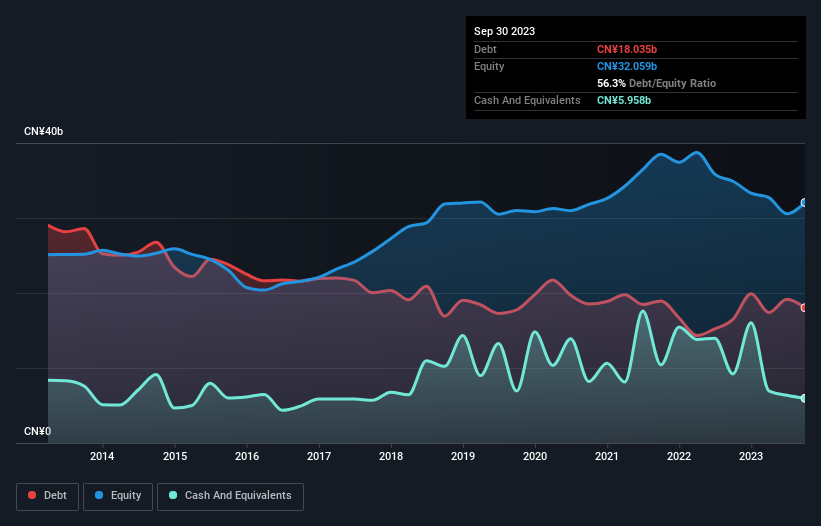
Legendary fund manager Li Lu (who Charlie Munger backed) once said, 'The biggest investment risk is not the volatility of prices, but whether you will suffer a permanent loss of capital.' It's only natural to consider a company's balance sheet when you examine how risky it is, since debt is often involved when a business collapses. We can see that Maanshan Iron & Steel Company Limited (HKG:323) does use debt in its business. But the real question is whether this debt is making the company risky.
What Risk Does Debt Bring?
Debt is a tool to help businesses grow, but if a business is incapable of paying off its lenders, then it exists at their mercy. Part and parcel of capitalism is the process of 'creative destruction' where failed businesses are mercilessly liquidated by their bankers. However, a more usual (but still expensive) situation is where a company must dilute shareholders at a cheap share price simply to get debt under control. Of course, plenty of companies use debt to fund growth, without any negative consequences. When we examine debt levels, we first consider both cash and debt levels, together.
Check out our latest analysis for Maanshan Iron & Steel
What Is Maanshan Iron & Steel's Debt?
As you can see below, at the end of September 2023, Maanshan Iron & Steel had CN¥18.0b of debt, up from CN¥16.5b a year ago. Click the image for more detail. On the flip side, it has CN¥5.96b in cash leading to net debt of about CN¥12.1b.

How Healthy Is Maanshan Iron & Steel's Balance Sheet?
The latest balance sheet data shows that Maanshan Iron & Steel had liabilities of CN¥45.0b due within a year, and liabilities of CN¥7.66b falling due after that. On the other hand, it had cash of CN¥5.96b and CN¥5.53b worth of receivables due within a year. So its liabilities outweigh the sum of its cash and (near-term) receivables by CN¥41.2b.
The deficiency here weighs heavily on the CN¥18.5b company itself, as if a child were struggling under the weight of an enormous back-pack full of books, his sports gear, and a trumpet. So we definitely think shareholders need to watch this one closely. At the end of the day, Maanshan Iron & Steel would probably need a major re-capitalization if its creditors were to demand repayment. The balance sheet is clearly the area to focus on when you are analysing debt. But ultimately the future profitability of the business will decide if Maanshan Iron & Steel can strengthen its balance sheet over time. So if you're focused on the future you can check out this free report showing analyst profit forecasts.
In the last year Maanshan Iron & Steel had a loss before interest and tax, and actually shrunk its revenue by 9.9%, to CN¥97b. That's not what we would hope to see.
Caveat Emptor
Importantly, Maanshan Iron & Steel had an earnings before interest and tax (EBIT) loss over the last year. Indeed, it lost a very considerable CN¥3.6b at the EBIT level. When we look at that alongside the significant liabilities, we're not particularly confident about the company. We'd want to see some strong near-term improvements before getting too interested in the stock. Not least because it had negative free cash flow of CN¥2.6b over the last twelve months. So suffice it to say we consider the stock to be risky. When we look at a riskier company, we like to check how their profits (or losses) are trending over time. Today, we're providing readers this interactive graph showing how Maanshan Iron & Steel's profit, revenue, and operating cashflow have changed over the last few years.
Of course, if you're the type of investor who prefers buying stocks without the burden of debt, then don't hesitate to discover our exclusive list of net cash growth stocks, today.
If you're looking to trade Maanshan Iron & Steel, open an account with the lowest-cost platform trusted by professionals, Interactive Brokers.
With clients in over 200 countries and territories, and access to 160 markets, IBKR lets you trade stocks, options, futures, forex, bonds and funds from a single integrated account.
Enjoy no hidden fees, no account minimums, and FX conversion rates as low as 0.03%, far better than what most brokers offer.
Sponsored ContentNew: Manage All Your Stock Portfolios in One Place
We've created the ultimate portfolio companion for stock investors, and it's free.
• Connect an unlimited number of Portfolios and see your total in one currency
• Be alerted to new Warning Signs or Risks via email or mobile
• Track the Fair Value of your stocks
Have feedback on this article? Concerned about the content? Get in touch with us directly. Alternatively, email editorial-team (at) simplywallst.com.
This article by Simply Wall St is general in nature. We provide commentary based on historical data and analyst forecasts only using an unbiased methodology and our articles are not intended to be financial advice. It does not constitute a recommendation to buy or sell any stock, and does not take account of your objectives, or your financial situation. We aim to bring you long-term focused analysis driven by fundamental data. Note that our analysis may not factor in the latest price-sensitive company announcements or qualitative material. Simply Wall St has no position in any stocks mentioned.
About SEHK:323
Maanshan Iron & Steel
Manufactures and sells iron and steel products, and related by-products in Mainland China, Hong Kong, and internationally.
Fair value with moderate growth potential.
Market Insights
Community Narratives



